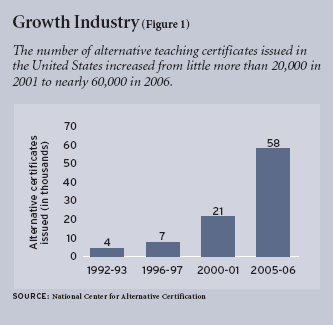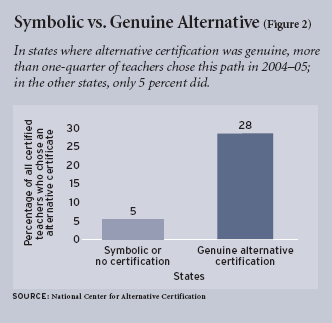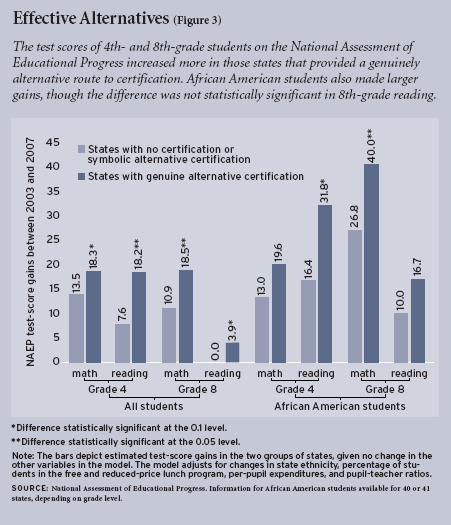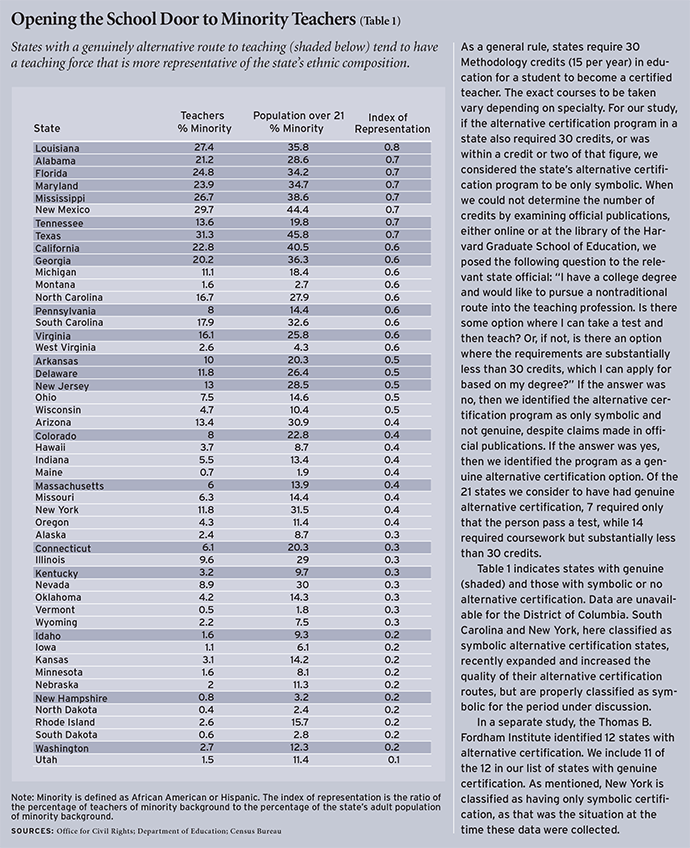Forty-seven states have adopted a pathway to teaching, alternative to the standard state certification otherwise required. Is this new pathway genuine or merely symbolic? Does it open the classroom door to teachers of minority background? Does it help—or hinder—learning in the classroom? Claims about all of these questions have arisen in public discourse. Recently, data have become available that allow us to check their validity.
To receive a standard state certification in most states, prospective teachers not only must be college graduates but also must have taken a specific set of education-related courses that comprise approximately 30 credit hours of coursework. Prospective teachers are well advised to pursue studies at a college or university within the state where they expect to teach, because it is often only within that state that students can get the courses required for state certification in the subject area and for the grade levels that they will be teaching.
Such certification requirements limit the supply of certified teachers, and as a result, serious teaching shortages are regularly observed. For example, in California, one-third of the entire teacher work force, about 100,000 teachers, will retire over the next decade and need to be replaced, compounding what the governor’s office calls a “severe” current teacher shortage. Other states are facing a similar situation. The National Council of Teachers of Mathematics projects a shortfall of 280,000 qualified math and science teachers by 2015. As former National Education Association president Reg Weaver put it, “At the start of every school year, we read in the newspaper…stories about schools scrambling to hire teachers.”
Teachers of minority background are in especially short supply. In 2004, only 14.1 percent of the nation’s teachers were African American or Hispanic, even though these ethnic groups comprised 26.5 percent of the adult population. That shortage has led to calls for remedial action. In the words of Weaver, “An impressive body of research confirms that recruiting and retaining more minority teachers can be crucial to” raising the achievement of minority students. “States and school districts need to develop programs…[that] reach out to minorities still in school, offering encouragement and incentives to enter the teaching profession. We need more minority teachers. School districts need to aggressively recruit them.”
The Certification Debate
Both colleges of education and teachers unions oppose any relaxation of certification requirements. In Weaver’s view, “The solution is not to develop alternative routes of entry into the profession or to increase the supply of recruits by allowing prospective teachers to skip ‘burdensome’ education courses or student teaching. The solution is to show a little R-E-S-P-E-C-T, and show us the money.”
According to this point of view, certification is necessary to ensure teacher quality, because teaching, like other professions (law, medicine, the sciences, and so forth), requires mastery of an esoteric body of substantive and pedagogical knowledge that cannot be obtained without undergoing a rigorous training program. Arthur Wise, former head of the National Council for Accreditation of Teacher Education, told the House Committee on Education and the Workforce, “Rigorous teacher preparation is key to ensuring that no child is left behind…. Content knowledge is only one indicator of readiness to teach…. [Schools of education] must prepare new teachers to teach the great diversity of students who are in America’s classrooms today.”
But Kate Walsh, president of the National Council on Teacher Quality, says that the “certification process” has only a “crude capacity for ensuring” quality teachers, because pedagogical “knowledge can be acquired by means other than coursework.” Teachers learn to teach by practicing the craft, not by taking coursework in its history or psychology. If that is so, then both the teaching shortage and the paucity of minority teachers can be alleviated by opening the classroom door to all college graduates, not just to those who have taken the required courses associated with state certification.
 Although no state has abandoned its traditional certification programs in response to calls for broader recruitment paths into education, all but three states have set up some kind of alternative certification pathway, and the number of alternatively certified teachers has steadily grown. In 2001, just 20,000 alternative teaching certificates were issued. By 2006, nearly 60,000 alternatively certified teachers were entering the teaching force each year, roughly one-fifth of new entrants (see Figure 1).
Although no state has abandoned its traditional certification programs in response to calls for broader recruitment paths into education, all but three states have set up some kind of alternative certification pathway, and the number of alternatively certified teachers has steadily grown. In 2001, just 20,000 alternative teaching certificates were issued. By 2006, nearly 60,000 alternatively certified teachers were entering the teaching force each year, roughly one-fifth of new entrants (see Figure 1).
In many states, however, the alternative certification requirements closely resemble traditional ones. As Chester Finn, president of the Thomas B. Fordham Institute (and Education Next senior editor), explains, “Typical alternative certification programs have come to mimic standard-issue pre-service college of education programs…. Alternative certification has been co-opted, compromised, and diluted. Education schools—brilliantly turning a threat into an opportunity—have themselves come to dominate this enterprise, blurring the distinctions that once made it ‘alternative.’”
Symbolic vs. Genuine Alternatives
To see which states have established genuine alternative certification programs and which have only symbolic ones of the kind described by Finn, we compared alternative certification rules to requirements for traditional certification in each state. We obtained information from state web sites as well as from publications available for prospective teachers at the Harvard Graduate School of Education. When necessary, we contacted relevant officials in state departments of education (see sidebar with Table 1).
Our research revealed that the design of alternative certification programs varies considerably from one state to the next. In 26 of the 47 states that allow alternative certification, the situation is as Finn describes, similar to standard-issue education school programs. But in the other 21 states, alternative teacher certification can be obtained without completion of most of the coursework associated with traditional certification (though the states may require additional coursework after a teacher secures a classroom position).
The variation in state practice allows us to provide some preliminary answers to questions frequently raised about alternative certification: Do states that provide a genuine alternative, not simply a symbolic one, recruit more teachers who take the alternative certification route? Do they open the classroom door to more minority teachers? What is the impact on student learning?
 The answer to the first question is very clear: it makes a good deal of difference whether alternative certification is meaningful or symbolic. In the 30 states that do not have genuine alternative certification, only 5 percent of the newly certified teachers chose the alternative route in 2004–05 (the most recent year for which information is available). Hardly anyone bothers with an alternative certificate if the requirements are essentially the same as for the traditional one. In the 21 states that offer genuine alternative certification, however, 28 percent of newly certified teachers utilize the option (see Figure 2). Altogether, 92 percent of those with an alternative teaching certificate received it in one of the 21 states that have such certification in reality as well as in name.
The answer to the first question is very clear: it makes a good deal of difference whether alternative certification is meaningful or symbolic. In the 30 states that do not have genuine alternative certification, only 5 percent of the newly certified teachers chose the alternative route in 2004–05 (the most recent year for which information is available). Hardly anyone bothers with an alternative certificate if the requirements are essentially the same as for the traditional one. In the 21 states that offer genuine alternative certification, however, 28 percent of newly certified teachers utilize the option (see Figure 2). Altogether, 92 percent of those with an alternative teaching certificate received it in one of the 21 states that have such certification in reality as well as in name.
Minority Representation
To the second question, there is also a fairly clear answer: minorities are represented in the teaching force to a greater extent in states with genuine alternative certification than in other states. Information on the number of minority teachers in each state is available from the Office for Civil Rights and the U.S. Department of Education. Together with census data, that information allows for the calculation of the ratio of minority teachers to minority adults for each state, which serves as an index of minority representation. If the index for a given state has a value of 1.0, then the percentage of minority teachers equals the percentage of minority adults in that state. If the index exceeds 1.0, then minorities are overrepresented in the teaching population; if the index is below 1.0, minorities areunderrepresented.
In 2004 (the most recent year for which data are available) minority teachers were seriously underrepresented in the nation’s public school classrooms. The nationwide ratio in 2004 was 0.53, which means that only a little more than half as many minority adults were teachers as one would expect, given the minority composition of the adult population.
The index of minority representation was nonetheless considerably higher in the 21 states with genuine alternative certification than in the 30 states with a symbolic substitute or no alternative certification (see Table 1). In the states with genuine alternative certification, the weighted average index of representation was 0.6, while in the states with a symbolic substitute or no alternative certification, the index was 0.2. In the three genuine alternative certification states with the largest total populations (California, Texas, and Florida), the index of representation was 0.56, 0.68, and 0.72, respectively, while in the three largest states with a merely symbolic or no alternative certification option (New York, Illinois, and Ohio), the index of representation was 0.38, 0.33, and 0.51, respectively. In other words, genuine alternative certification seems to give minority adults interested in a career in education greater opportunity to become a teacher.
Of course, minority teachers may be recruited by avenues other than alternative certification. Sixteen states report the ethnic background of alternatively certified teachers to the U.S. Department of Education. In 14 of them, the percentage minority for those alternatively certified exceeds by a wide margin the percentage minority of the state’s teaching force as a whole. In Mississippi, for example, the disparities are massive: 60 percent of the more than 800 teachers who were alternatively certified in 2004–05 were of minority background, while the overall Mississippi teaching force is just 26 percent minority. Other states where percentage differences between the two groups exceed at least 10 percentage points include California, Delaware, and Texas. In other words, there is every reason to believe that alternative certification is key to recruiting more minorities into the teaching profession.
Impact on Student Learning
But is alternative certification, however desirable a device for recruiting minorities into the teaching profession, impairing student learning? That is ultimately the justification for traditional teacher certification, regardless of its consequences for teacher shortages or for the recruitment of minority teachers. And that apparently is the rationale for those who interpret the federal No Child Left Behind (NCLB) act as requiring a certified teacher in every classroom, the basis for the complaint in the California case Renee v. Spellings. That suit objects to the presence in classrooms of teachers who have not received traditional certification.
Most studies show very little, if any, connection with a teacher’s classroom effectiveness and certification status. Harvard economist Thomas Kane and his colleagues (see “Photo Finish,” research, Winter 2007) found no difference between the amount of learning taking place in New York City classrooms under the direction of non-certified teachers and in those under the direction of regularly certified ones.
Nor is there convincing evidence that minority teachers are less effective at teaching minority students. On the contrary, the results from an experiment conducted in Tennessee (see “The Race Connection,” research, Spring 2004) indicate that minority students learn more from teachers of their own ethnicity than from other teachers.
Our results are consistent with that research and other studies that have found little reason to equate certification with “highly qualified.” Students attending schools in states with genuine alternative certification gained more on the National Assessment of Educational Progress (NAEP) between 2003 and 2007 than did students in the other states. The finding holds, even when one adjusts for changes in the ethnic composition, free-lunch eligibility,class size, and education expenditures for each state (see Figure 3).

In states that had genuine alternative certification, test-score gains on the NAEP exceeded those in the other states by 4.8 points and 7.6 points in 4th- and 8th-grade math, respectively. In reading, the additional gains in the states with genuine alternative certification were 10.6 points and 3.9 points for the two grade levels, respectively. Among African Americans, test-score gains were also larger in the states with genuine alternative certification.
It is possible that the disproportionately large gains in test-score performance in the states with genuine alternative certification were due to some other factor, possibly other education reforms those states were introducing at the same time they were widening the door to the teaching profession. We cannot dismiss this possibility, inasmuch as we were able to control only for changes in certain demographic and policy variables, not for changes in other state policies that might explain the difference in test-score gains among states.
But the burden of proof would now seem to shift to the plaintiffs in the Renee v. Spellings case, who argue that traditional state certification is necessary to ensure teacher quality. Genuine alternative certification opens the door to more minority teachers, and student learning is more rapid in states where the reform has been introduced. Meanwhile, scientific evidence that alternative certification harms students remains somewhere between scant and nonexistent.
–Paul E. Peterson, director of the Harvard Program on Education Policy and Governance (PEPG), is editor-in-chief of Education Next. Daniel Nadler is a PEPG research associate.



